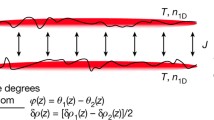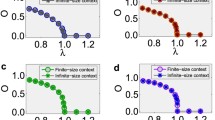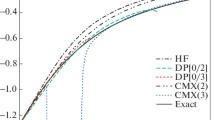Abstract
We outline a partial-fractions decomposition method for determining the one-particle spectral function and single-particle density of states of a correlated electronic system on a finite lattice in the non self-consistent T-matrix approximation to arbitrary numerical accuracy, and demonstrate the application of these ideas to the attractive Hubbard model. We then demonstrate the effectiveness of a finite-size scaling ansatz which allows for the extraction of quantities of interest in the thermodynamic limit from this method. In this approximation, in one or two dimensions, for any finite lattice or in the thermodynamic limit, a pseudogap is present and its energy diverges as T c is approached from above; this is an unphysical manifestation of using an approximation that predicts a spurious phase transition in one or two dimensions. However, in three dimensions one expects the transition predicted by the approximation to represent a true continuous phase transition, and whether or not a pseudo gap exists in the thermodynamic limit in three dimensions remains an open question. We have applied our method to the attractive Hubbard model on a three-dimensional simple cubic lattice, and find, similar to previous work, that for intermediate coupling a prominent pseudogap is found in the single-particle density of states, and this gap persists over a large temperature range. In addition, we also show that for weak coupling (an on-site Hubbard energy equal to one quarter the bandwidth) a pseudogap is also present. The pseudogap energy at the transition temperature is almost a factor of three larger than the T = 0 BCS gap for intermediate coupling, whereas for weak coupling the pseudogap and T = 0 BCS gap energies are essentially equal. These results show that a pseudogap due to superconducting fluctuations occurs in three dimensions even in the weak-coupling limit.
Similar content being viewed by others
REFERENCES
J. Bardeen, L. N. Cooper, and J. R. Schrieffer, Phys. Rev. 106, 162 (1957); Phys. Rev. 108, 1175 (1957).
P. W. Anderson, Phys. Rev. 112, 1900 (1958).
N. N. Bogoliubov, N. V. Tolmachev, and D. V. Shirkov, A New Method in the Theory of Superconductivity, Consultants Bureau, Inc., New York (1959).
G. Rickayzen, Phys. Rev. 115, 795 (1959).
A. Bardasis and J. R. Schrieffer, Phys. Rev. 121, 1050 (1961).
A. B. Migdal, Zh. Eksp. Teor. Fiz. 34, 1438 (1958) [Sov. Phys. JETP 7, 996 (1958)].
G. M. Eliashberg, Zh. Eksperim. i Teor. Fiz. 38966 (1960) [Soviet Phys. JETP 11696 (1960)].
See the various articles in Superconductivity, edited by R. D. Parks (Marcel Dekker, New York, 1969).
V. L. Ginzburg and L. D. Landau, Zh. Eksp. Teor. Fiz. 20, 1064 (1950).
A. S. Alexandrov and N. Mott, Polarons and Bipolarons (World Scientific, Singapore, 1995), and references therein.
D. Feinberg, S. Ciuchi, and F. de Pasquale, Int. J. Mod. Phys. B 4, 1317 (1990).
D. Emin, Phys. Rev. B 48, 13691 (1993).
J. Ranninger, in Bose-Einstein Condensation, eds. A. Griffin, D.W. Snoke, and S. Stringari,( Cambridge University Press, 1995), p. 393.
V. J. Emery and S. A. Kivelson, Nature 374, 434 (1995).
M. Randeria, in Bose-Einstein Condensation, eds. A. Griffin, D.W. Snoke, and S. Stringari,( Cambridge University Press, 1995), p. 355.
P. B. Allen, in Modern Trends in the Theory of Condensed Matter, Proceedings, Karpacz, 1979, eds. A. Pekalski and J. Przystawa, (Springer Verlag, New York, 1980), p. 388.
V. Ambegaokar, in Superconductivity, ed. R. D. Parks (Marcel Dekker, New York, 1969) Vol. 1, p. 259.
D. J. Thouless, Ann. Phys. 10, 553 (1960).
K. Kanamori, Prog. Theor. Phys. 30, 275 (1963).
A. L. Fetter and J. D. Walecka, Quantum Theory of Many-Particle Systems (McGraw-Hill, New York, 1971).
L. P. Kadanoff and P. C. Martin, Phys. Rev 124, 670 (1961).
G. Baym and L. P. Kadanoff, Phys. Rev. 124, 287 (1961).
G. Baym, Phys. Rev. 1271391 (1962).
D. M. Eagles, Phys. Rev. 186, 456 (1969).
A. Schmid, Z. Physik 231, 324 (1970).
S. Mar?celja, Phys. Rev. B 1, 2351 (1970). Demonstration of a Robust Pseudogap 215
B. R. Patton, Phys. Rev. Lett. 27, 1273 (1971); PhD thesis (Cornell), 1970.
V. M. Loktev, R. M. Quick, and S. G. Sharapov, Phys. Repts. 349, 2 (2001).
B. Janko, J. Maly, and K. Levin, Phys. Rev. B 56, 11407 (1997);. Kosztin, Q. Chen, B. Janko, and K. Levin, Phys. Rev. B 58, 5936 (1998). See also Q. Chen, K. Levin, and I. Kosztin, Phys. Rev. B 63, 184519 (2001), and references therein.
N. E. Bickers, D. J. Scalapino, and S. R. White, Phys. Rev. Lett. 62, 961 (1989); N. E. Bickers and D. J. Scalapino, Ann. Phys. (N.Y.) 193, 206 (1989); N. E. Bickers and S. R. White, Phys. Rev. B 43, 8044 (1991).
S. Verga, F. Marsiglio, and R. J. Gooding (to be submitted).
J. Vilk and A.-M. S. Tremblay, J. de Physique I (France) 7, 1309 (1997).
A. J. Leggett, J. de Physique, C7, 41, 19 (1980); A. J. Leggett, in Modern Trends in the Theory of Condensed Matter, eds. S. Pekalski and J. Przystawa (Springer, Berlin, 1980) p. 13.
P. Nozi`eres and S. Schmitt-Rink, J. Low Temp. Phys. 59, 195 (1985).
S. Schmitt-Rink, C. Varma, and A. E. Ruckenstein, Phys. Rev. Lett. 63, 445 (1989).
J. M. Luttinger, Phys. Rev. 119, 1153 (1960).
J. Serene, Phys. Rev. B 40, 10873 (1989).
A. Tokumitu, K. Miyake, and K. Yamada, Phys. Rev. B 4711988 (1993).
K. S. D. Beach, R. J. Gooding, and F. Marsiglio, Phys. Lett. A 282, 319 (2001).
R. Frèsard, B. Glaser, and P. Wölfle, J. Phys. Cond. Mat. 4, 8565 (1992).
R. Haussmann, Z. Phys. B 91, 291 (1993); R. Haussmann, Phys. Rev. B 49, 12975 (1994).
M. Y. Kagan, R. Frèsard, M. Capezzali, and H. Beck, Phys. Rev. B 57, 5995 (1998).
B. Kyung, E. G. Klepfish, and P. E. Kornilovitch, Phys. Rev. Lett. 80, 3109 (1998).
V. P. Gusynin, V. M. Loktev, and S. G. Sharapov, JETP 88, 685 (1999).
J. R. Engelbrecht and A. Nazarenko, Europhys. Lett. 51, 96 (2000).
D. Rohe and W. Metzner, Phys. Rev. B 63, 224509 (2001).
Y. Yanase and K. Yamada, J. Phys. Soc. Jpn. 70, 1659 (2001).
J. Quintanilla, B. L. Györffy, J. F. Annett, and J. P. Wallington, Phys. Rev. B 66, 214526 (2002).
P. Pieri and G. C. Strinati, Phys. Rev. B 61, 15370 (2000).
S. Allen and A.-M. S. Tremblay, Phys. Rev. B 64, 075115 (2001).
B. Kyung, S. Allen, and A.-M. S. Tremblay, Phys. Rev. B64, 075116 (2001).
We make this statement with the understanding that we are not attempting to discuss Kosterlitz-Thouless physics in this paper.
T. Timusk and B. W. Statt, Rep. Prog. Phys. 62, 61 (1999).
J. E. Hirsch, J. Stat. Phys. 43, 841 (1986); Phys. Rev. B 351851 (1987).
S. Robaszkiewicz, R. Micnas, and K. A. Chao, Phys. Rev. B 24, 1579 (1981); Phys. Rev. B 24, 4018 (1981); Phys. Rev. B 26, 3915 (1982). R. Micnas, J. Ranninger, and S. Robaszkiewicz, Rev. Mod. Phys. 62, 113 (1990). R. Micnas, M. H. Pedersen, S. Schafroth, T. Schneider, J. J. Rodrguez-Núlbez, and H. Beck, Phys. Rev. B 52, 16223 (1995).
Q. Chen, I. Kosztin, B. Jankó, and K. Levin, Phys. Rev. B 59, 7083 (1999).
G. Preosti, Y. M. Vilk, and M. R. Norman, Phys. Rev. B 59, 1474 (1999).
J. R. Engelbrecht and H. Zhao, cond-mat/0110356; J. R. Engelbrecht, H. Zhao, and A. Nazarenko, J. Phys. Chem. Solids 63, 2237 (2002).
G. Rickayzen, Green's Functions and Condensed Matter (Academic Press, Toronto, 1980).
H. Fukuyama, O. Narikiyo, and Y. Hasegawa, J. Phys. Soc. Jpn. 60, 372 (1991); H. Fukuyama, Y. Hasegawa, and O. Narikiyo, J. Phys. Soc. Jpn. 60, 2013 (1991).
F. Marsiglio and R. J. Gooding (unpublished).
This terminology was first used in T. Gherghetta and Y. Nambu, Phys. Rev. B 49, 740 (1994).
Due to several important technicalities, e.g., to ensure that we purge spurious double poles from any expansion generated by this algorithm, a very high numerical accuracy is required. We have coded in MapleVr5.1 to achieve the extraction of these numbers, 216 R. J. Gooding et al.and have used a relative accuracy as high as 10-150, noting that such a number can be required for converged and accurate pole and residue evaluations.
N. D. Mermin and Wagner, Phys. Rev. Lett. 17, 1133, 1307 (1966); P. C. Hohenberg, Phys. Rev. 158, 383 (1967).
A. Moreo, D. J. Scalapino, R. L. Sugar, S. R. White, and N. E. Bickers, Phys. Rev. B 41, 2313(1990).
J. R. Schrieffer, X.-G. Wen, and S. C. Zhang, Phys. Rev. B 39, 11663 (1989).
We note that to complete the U /t= 3 analysis we have had to use a smaller broadening parameter of 0.12t, in contrast to the value of 0.36tused for U /t= 6. This is because the energy scales are much smaller, and a broadening of 0.36tis in fact more than 50% of the BCS gap; to properly resolve the energies for smaller U /twe thus used a smaller broadening.
Author information
Authors and Affiliations
Rights and permissions
About this article
Cite this article
Gooding, R.J., Marsiglio, F., Verga, S. et al. Demonstration of a Robust Pseudogap in a Three-Dimensional Correlated Electronic System. Journal of Low Temperature Physics 136, 191–216 (2004). https://doi.org/10.1023/B:JOLT.0000038522.13017.42
Issue Date:
DOI: https://doi.org/10.1023/B:JOLT.0000038522.13017.42




